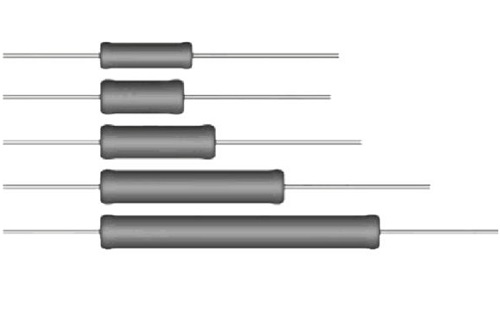Position:Home » Technical Articles
Through Hole Resistor: Radial lead and Axial Lead
Writer:Microhm Page View:Date:2019-06-20
A questions that comes up from time to time is what does axial or radial leaded mean? This is calling out how the leads comes out of the component. Axial leaded components will have a lead or multiple leads coming out of each end of the component.
Structurally, using a form of carbon powder mixed with an insulating material, which does not conduct electricity at all, forms most through hole resistors. This is mixed with a paste or resin to create a solid inner core of the resistor, the conductive path. The ultimate resistance of the device is determined by how much carbon fiber there is relative to the insulating material within the core, or the ratio between them. The more carbon, the lower the resistance. To protect the core, a plastic shell is often placed around it, and two thin wire terminals attach to each end.


Radial which many people think is the shape of the component is actually calling out that the leads are coming out the same side of the component. Radial lead type of thin film resistors has the tightest resistance tolerance and the smallest TCR, and is mounted on the insert type PCB board.

Axial leaded resistors are typically simple cylindrical components with a long terminal pins on either side which can be bent to conform to a variety of hole layouts on a PCB. Often they are color coded with an industry-standard code that displays the ohmage rating of the device. They have a wide range of variability, with the same package sizeable to accommodate an impedance of less than 1 ohm up through 10s of millions.

Radial which many people think is the shape of the component is actually calling out that the leads are coming out the same side of the component. Radial lead type of thin film resistors has the tightest resistance tolerance and the smallest TCR, and is mounted on the insert type PCB board.
Keywords:
Latest News
- Resistor's role in measuring and correcting LED,,,
- Single through-hole resistors' characteristics ,,,
- Why shunt resistors for current sense applicati,,,
- Metal-film resistors with small size, high resi,,,
- 36W High-Current Shunt Resistors MMS8420,,,
- 1W Surface Mount Resistor MPR1206,,,
- An Overview of Microhm Electronics' Resistor Pr,,,
- More anti-sulfur resistors used in harsh envir,,,
- Resistance changes with temperature,,,
- 140W TO247 High Power Heatsinkable Resistor,,,
- MMS5930 is ideal for current sensing in industr,,,
- Shunt resistors selection for engineers' design,,,
- Considerations for choosing precision resistors,,,
- Ceramic Encased Cement Resistors NWH Series for,,,
- Resistors for Passive Balancing in Battery-Pow,,,
Hot Articles
- Microhm will take part in 10th Automotive World,,,
- Thanks for Visiting Microhm's Booth E5-5706 in ,,,
- Resistors in Short Supply: Blame Cars,,,
- New lunch: High Power Precision Shunt Resistor,,,,
- How to Test a Resistor,,,
- Innovative Technology, Future Electric: Electri,,,
- What is Precision Resistors?,,,
- SMD Resistors Sizes and Packages,,,
- The Construction and Features of Metal Film Res,,,
- What is a TO-220 Resisor?,,,
- Hot Selling Products: Precision Shunt Resistors,,,
- How to Calculate the Equivalent Resistance Valu,,,
- What is a Fixed Resistor?,,,
- Resistors in LED Circuits,,,
- Resistors Types and Materials Overview,,,
Resistance applications
- Miniature future for passive electronic compone,,,
- The Four Important Functions of Alloy Resistors,,,
- BMS for New Energy Vehicle,,,
- Why Zero-Ohm Resistors?,,,
- Precision Resistors' Construction and TCR,,,
- Difference Between High Precision Resistors and,,,
- The Measurement Accuracy of Automotive Shunt is,,,
- Urbanization Development Bringing the Transform,,,
- Select the Right Resistor for Harmonic Filterin,,,
- Shunt Resistor MMS8420 for High Current Stable ,,,
- Carbon Film Resistors' Features and Application,,,
- Industrial Roberts Applied to Solar Photovoltai,,,
- Surface Mount Resistor's Size and Package ,,,
- The Main Application for High Precision and Low,,,
- Heater Blower Motor Resistor in Air Conditioner,,,
